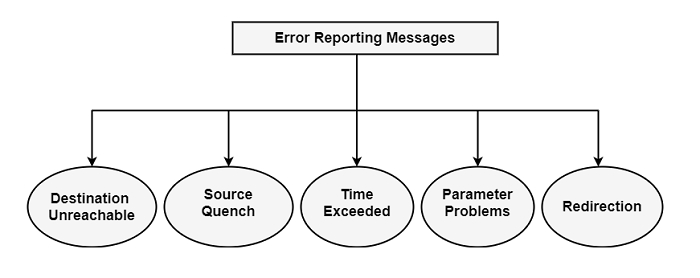
 Data Structure
Data Structure Networking
Networking RDBMS
RDBMS Operating System
Operating System Java
Java MS Excel
MS Excel iOS
iOS HTML
HTML CSS
CSS Android
Android Python
Python C Programming
C Programming C++
C++ C#
C# MongoDB
MongoDB MySQL
MySQL Javascript
Javascript PHP
PHP
- Selected Reading
- UPSC IAS Exams Notes
- Developer's Best Practices
- Questions and Answers
- Effective Resume Writing
- HR Interview Questions
- Computer Glossary
- Who is Who
Explain the Error Reporting Messages in ICMP Protocol
The error-reporting message defines that the router encounters a problem when it processes an IP packet, then it reports a message. Error messages are continually transmitted to the original source because the only data possible in the datagram around the route is the source and destination IP addresses.
The error reporting messages are generally classified into the following types−

When a router cannot route a datagram, or a host cannot transfer a datagram, the datagram is rejected, and the router or the host share a destination-unreachable message back to the source host that proposed the datagram.
Destination unreachable messages with codes 2 or 3 can be created only by the destination host. Other destinations unreachable messages can be created only by routers.
Source Quench
There is no flow-control mechanism in the IP protocol. The lack of flow control can generate congestion in routers or the destination host. A router is a host that has a limited size queue (buffer) for incoming datagrams waiting to be forwarded or to be processed.
If the datagrams are received much quicker than they can be forwarded or processed, the queue may overflow. In this case, their router or the host has no choice but to discard some of the datagrams.
Time Exceeded
The time exceeded message is generated in two cases−
- Whenever a router gets a datagram with a time-to-live value of zero, it discards the datagram and shares a time exceeded message to the original source.
- When the last destination does not obtain all of the fragments in a set time, it removes the received fragments and sends a time-exceeded message to the original source. In a time-exceeded message, code 0 can be used only by routers to display that the cost of the time-to-live area is zero. Code 1 can be used only by the destination host to display that not all of the fragments have arrived within a set time.
Parameter Problem
Any ambiguity in the header part of a datagram can generate serious issues as the datagram travels by the Internet. If a router or the destination host finds an ambiguous or missing cost in any area of the datagram, it removes the datagram and sends a parameter-problem message back to the source.
Redirection
A host usually starts with a small routing table that is gradually augmented and updated. One of the tools to accomplish the redirection message.

